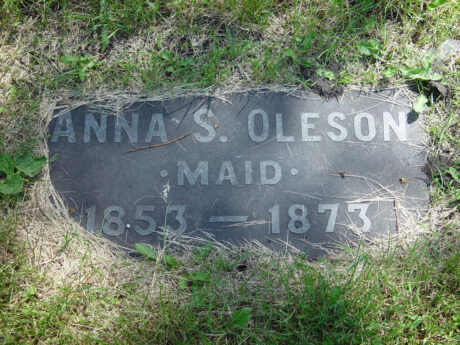from the series Tales from Pioneers and Soldiers Memorial Cemetery
224th in a series
By SUE HUNTER WEIR

In her novel Sing, Unburied, Sing, author Jesmyn Ward describes ghosts not as supernatural beings but as “unfinished stories.”
There are many such ghosts in the Minneapolis Pioneers and Soldiers Memorial Cemetery. In the case of Mary Hampson, cemetery records do not provide a satisfactory ending to her story. They don’t even provide a satisfactory beginning. All that was known about her at the time of her death was that she died on September 20, 1881 (and even that is not a certainty), and that she was buried in Lot 54 at the south end of Block F. Her name is given as “Miss” Mary Hampson. There’s not much of a story there, but there was more to be learned about her.
Mary appeared in the 1880 Federal Census, something that, because she was a servant, was unusual. And, she was very young—only 15 years old. She was exactly the type of person that enumerators missed when counting the city’s residents.
According to that census, Mary, the daughter of Irish immigrants, was born in New York in 1865. It’s not clear how or why she came to Minnesota and whether she traveled with other people or alone. But in 1880, she was employed as a servant at the Women’s Home. The Home was run by the Women’s Christian Association, an alliance of several Protestant churches which provided some financial support. The rest came from private benefactors and a variety of volunteers’ fundraising activities such as bazaars, musical programs, and festivals.
The Women’s Home was established in 1871, initially to aid “fallen women,” but their mission seemed to have expanded over the next ten years. By the time that Mary worked there, the Home provided housing to as many as 30 women, most of them working as teachers, seamstresses and clerks in retail stores. One woman who lived there during Mary’s employment was a science teacher and naturalist named Eloise Butler, who became so well known that Minneapolis’s Eloise Butler Wildflower Garden and Bird Sanctuary was named in her honor.
There is something else that is somewhat unusual about Mary’s story. On September 23, 1881, the Minneapolis Tribune published the following announcement:
“The funeral of Mary Hampson, who died at the Cottage Hospital of typhoid fever yesterday will take place this morning at 9 a.m.”
The deaths of young women who worked as domestics were not often reported in the paper. This announcement, as brief as it was, tells us how and where Mary died.
One likely explanation for its having been published is that Mary died in the Cottage Hospital. The Hospital, the first of its kind in Minneapolis, was a charity hospital organized by the Brothers of Gethsemane and supported by the wives of many prominent Minneapolitans. It had only been open for about six months when Mary died. There was considerable public interest and controversy around the hospital, which led to a number of stories about it appearing in the paper. Like the Women’s Home, the hospital relied on benefactors and reimbursements from the County for services provided to the poor, an idea that did not sit well with everyone.
Mary died about a year after the 1880 census was taken. She was only 16 years old. The Hospital where she died had a clear mission: to provide care for the sick, the poor, and the friendless. There is no doubt that Mary was sick and she was almost certainly poor. But she does not appear to have been friendless. Someone must have cared for her and wanted her to have what, at the time, was considered a respectable burial. Although her grave is unmarked, she was not buried in the cemetery’s paupers’ section. Someone made arrangements and paid for her funeral.
This may be as much about Mary that we will ever know, and in some ways it’s surprising that we know this much. She is slightly less ghostly now, but her story is still far from finished. Rest in peace, Mary.
Sue Hunter Weir is chair of Friends of the Cemetery, an organization dedicated to preserving and maintaining Minneapolis Pioneers and Soldiers Memorial Cemetery. She has lived in Phillips for almost 50 years and loves living in such a historic community.









